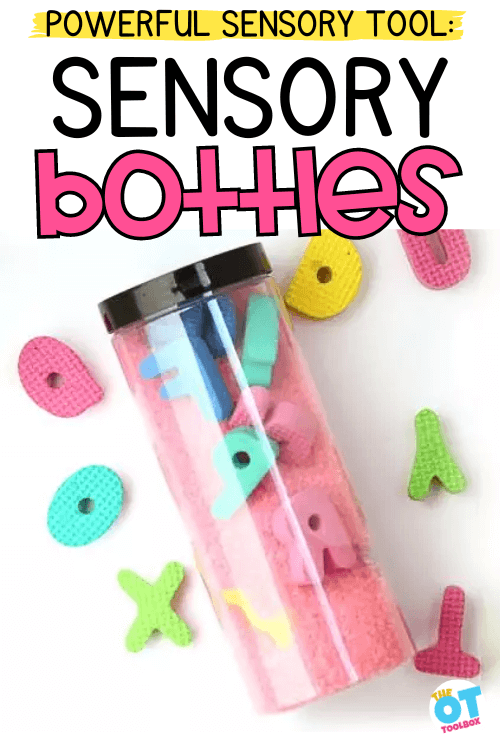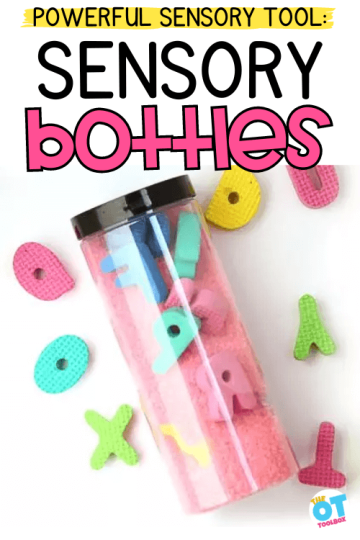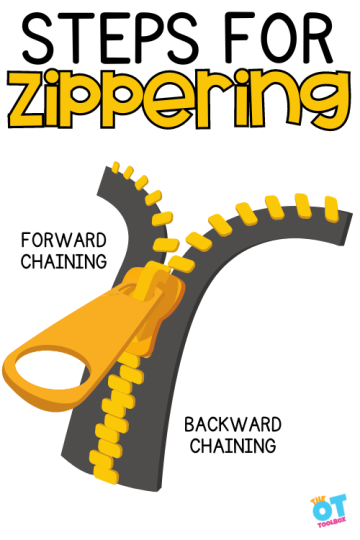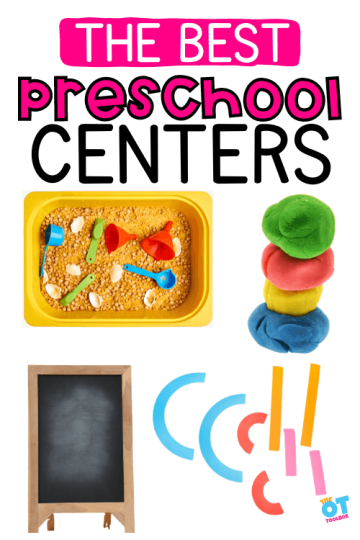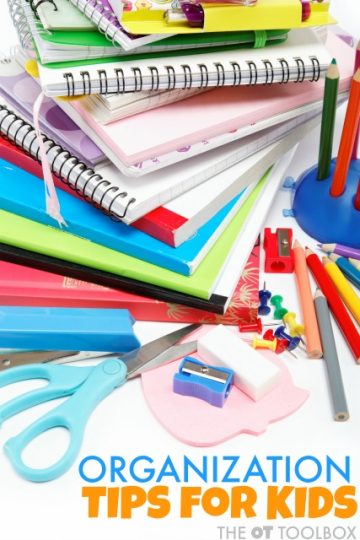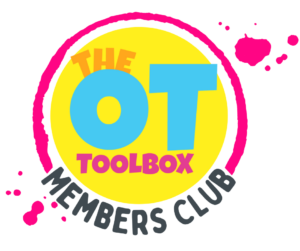Today, we have a great life skills activity: specifically, laundry skills! In this blog post, we are discussing the life skill of laundry. Washing and drying clothes is an independent living task that anyone who manages their activities of daily living and instrumental activities of daily living must learn. Getting dressed each day requires clean clothing. And in order to manage and wear clean clothing, dirty clothes must be laundered! Whether you are looking for information on teaching laundry skills to teens, or working in a special needs classroom with special education students in a life skills classroom or group home, laundry skills are a part of occupational therapy interventions. You’ll also want to check out our cooking life skills activities for more ways to support IADLs.
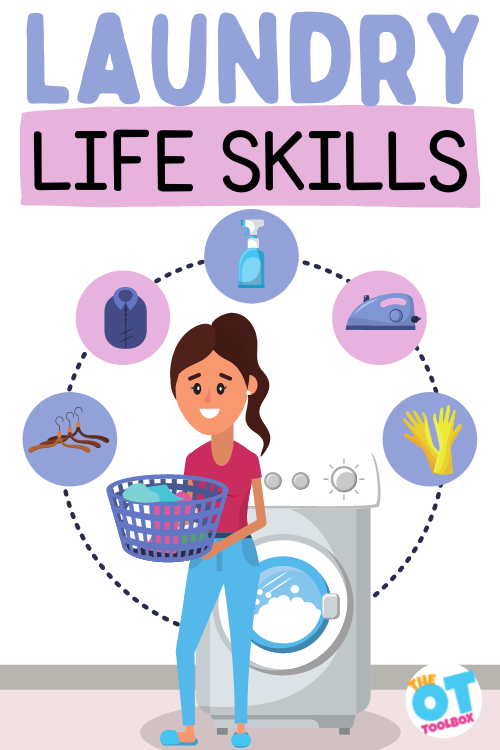
Laundry Skills
Don’t you just love those 12 seconds when the laundry is all done? Laundry is the gift that keeps on giving. Laundry life skills are necessary and inevitable. Unless you plan to do your kid’s laundry for the rest of their lives, start teaching laundry skills early.
Teenager Laundry Schedule
Washing: 30 minutes
Drying: 30 minutes
Folding and putting away: 7-10 business days
How do you know when it is really time for your kids to learn laundry skills?
- When half of the clean laundry ends up in the dirty basket unworn
- When they wear like seven outfits a day
- Clothes are so wrinkled in the drawers, they have to be rewashed to be worn
- They ask you to do laundry so often because they only wear their favorite three things
Laundry Life Skills Learning Lessons
People learn by doing. They also learn by making mistakes. Suffering natural consequences versus being nagged at or scolded, is a better way for people to learn. These are some valuable life lessons my teenagers learned while learning to do laundry properly.
- Teenager claims they need more underwear and socks. Turns out they are all just dirty
- They shove so many clothes into the washer, the clothes are barely wet
- Everything goes in the same load, creating lovely pink blobs on everything
- The laundry stays in the washer for five days. EWWW
- The laundry stays in the dryer for five days. Has to be rewashed
- Your kid looks like they dragged their clothes out of a garbage bag each time they get dressed
- Your teen does not do laundry until the only option left is their prom dress!
- Too much soap, not enough soap, hot water, you get the picture
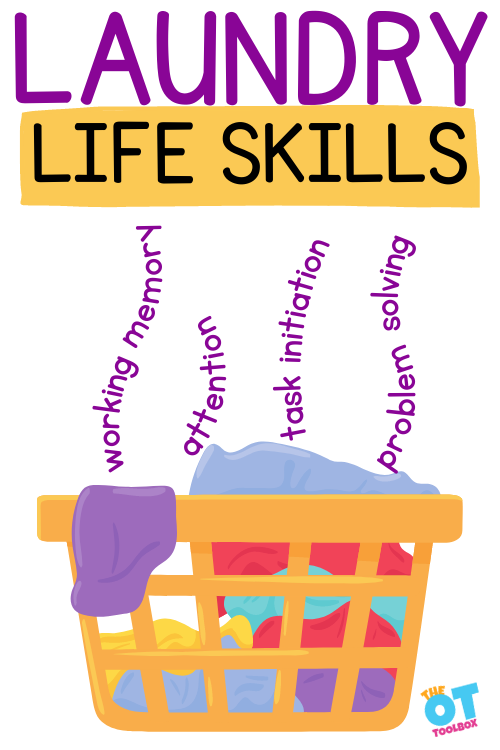
Laundry Skills Require Underlying Areas
With the many aspects that go into laundry skills, there are many underlying areas of development that impact teaching laundry.
The underlying areas of laudrying include:
- Fine motor skills: pinch and grip strength, coordination
- Gross motor skills: upper body strength, core strength, balance, coordination, posture, stability, range of motion
- Visual motor skills: eye-hand coordination,
- Visual perceptual skills: visual discrimination, visual scanning, visual figure ground, form constancy,
- Sensory motor skills: Tactile discrimination, proprioceptive input, vestibular input, visual processing, auditory processing
- Executive functioning skills: task initiation, task completion, working memory, attention, organization
- Cognitive skills: Direction following, problem solving, safety awareness
With all of these considerations it’s no wonder that laundry skills are a challenge for all ages!
Tips and Strategies for teaching Laundry Skills
These tips are helpful for all learning, not just laundry.
- Break the tasks down into smaller chunks to make them more manageable. The learner may not be able to do all their laundry, but can probably stuff the items in a basket or washer.
- Choose times for learning when there is not a rush. Learners cannot work under pressure.
- Set realistic expectations. Your two year old might not be able to fold clothes properly. That’s ok, they can put them in the basket.
- Accept mediocracy. Learn to accept the towels and sheets will not be folded correctly. Be happy they are clean and in the closet.
- Think first about any sensory/motor/logistical components of the task and problem solve before starting.
- Backward or forward chain. Backward chain would be to do all of the work for your learner, then have them come in and finish the final step. This offers a sense of accomplishment. Forward chaining is having your learner do the first step, before they become overwhelmed, then you finish for them. This gives confidence that they can do some of the laundry task.
- There are many laundry steps for a learner to remember during any life skills task.
- Minimize distractions and sensory input prior to starting.
- Stay calm and do not add more pressure.
- Let your learner do for themselves, only intervening when they start to get upset. Do not rush to fix everything so quickly. They will not learn that there is a problem if we constantly fix the errors before they notice.
- Give the learner opportunities to be independent, even at a small task.
- If your learner has sensory related concerns, the OT Toolbox has a great resource called the Sensory Lifestyle Handbook, with checklists and strategies to weave sensory activities into your learner’s day
Laundry Checklist
Laundry skills involves many steps. It’s because of this multi-step process, that sometimes the task “falls apart”. Laundry skills includes the following basic steps:
- Sorting clothing by light and dark colors or by fabric. For some individuals, starting with a sorting task is a great first step. Use these sorting colors ideas.
- Placing clothing into a hamper or clothes basket and emptying pockets.
- Carrying a full basket of clothes.
- Lifting a full basket to empty into a washer. Or bending/reaching to place dirty clothes into the washing machine.
- Pre-treating any stains.
- Adding the correct amount of detergent, the appropriate type of laundry detergent, and motor tasks such as: opening the detergent bottle, pouring the correct amount of soap, adding the soap to the correct place in the washing machine.
- Using an appropriate load size for the washing machine and the clothing type.
- Selecting a water temperature appropriate for the clothing fabric type, such as using cold water for certain clothing fabrics and using warm water over hot water for others.
- Turning on settings for the appropriate wash cycle.
- Remembering to listen for the laundry machine buzzer or setting an alarm for the end of the washing cycle.
- Removing wet clothing and placing into a dryer.
- Removing any clothing that needs to air dry.
- Selecting the right amount of drying time for the clothing from the dryer’s settings
- Turning the dial to the appropriate setting.
- Using an appropriate dryer load size.
- Setting an alarm or remembering to remove dry clothing from the dryer when complete (task completion).
- Removing all of the dry clothing from the dryer.
- Folding clothing, including how to fold pants, shirts, and other types of clothing.
- Matching and rolling socks together.
- Putting away clothing.
- Hanging clothing on hangers when appropriate.
No wonder laundry skills are such a complex task!
“Sometimes you might feel like no one is there for you. You know who is always there for you? Laundry. Laundry will always be there for you.” Author Unknown
Other Benefits of Doing Life Skills like Laundry
- Allows more free time for parents to focus on other things
- Instills a sense of responsibility for their belongings
- Builds executive function skills – starting and finishing a project, time management, planning, prioritizing, and foresight to name a few. The OT Toolbox has a FREE course on developing executive function and several resources on this valuable life skill.
- The task can be adjusted to meet levels, whether developmental disabilities are present or specific areas of need: motor planning, executive functioning skills, physical abilities etc.
- Sensory processing skills and self regulation. Heavy work is a great way to regulate the sensory system through proprioception. Laundry has built in heavy work from filling the laundry basket, pulling or pushing the basket, piling clothes into the washer, dragging wet clothes out of the washer, pushing them into the dryer, and pulling them out. There are other senses alerted in a negative or positive way during laundry, such as smell of detergent, feeling the water on the clothes, the sound of the washer and dryer, or the warm feeling of clothes fresh out of the dryer.
- Builds independence and self reliance.
How to develop laundry life skills (or any other skills):
If you sit a seven year old down and ask them to do laundry, you will be met with either dread, frustration, or shutdown. The task in entirety is too much all at once. Not only can you break the task into measurable chunks, use the following adaptations to build laundry or any other life skills:
- Print a laundry checklist with clear laundry steps and directions. Read here about visual schedules that can be used as a support.
- Use a picture story sequence to walk through the task using real images of the individual completing the laundry task.
- Make a social story about doing laundry so your learner gets a clear picture of the task ahead of time
- Create a picture board with cards and velcro to move items from the “to do” to the “done” side.
- Create visual reminders in the laundry area to assist with the chore such as how much detergent, what temperature for the clothes
- Adapt and modify the task as needed. Determine what the barriers might be to making this task independent for your learner. Create folding boards to fold shirts, use laundry pods instead of measured detergent, wash all items on cold for ease, different colored baskets if sorting items, a clear system of where everything belongs, step stools if needed.
- If you are hitting roadblocks when addressing life skills, there may be a motor or sensory component making skill acquisition more difficult. Problem solve these first, then move forward. The book, (affiliate link) Seeing Your Home and Community with Sensory Eyes is a great resource to problem solve and find solutions to everyday events such as going to bed, bathing, cooking, riding the bus, going to the dentist, doing chores, or the dreaded cafeteria.
After catching up on laundry this week, I am implementing prison rules. Each member gets one jumpsuit for the week.

Victoria Wood, OTR/L is a contributor to The OT Toolbox and has been providing Occupational Therapy treatment in pediatrics for more than 25 years. She has practiced in hospital settings (inpatient, outpatient, NICU, PICU), school systems, and outpatient clinics in several states. She has treated hundreds of children with various sensory processing dysfunction in the areas of behavior, gross/fine motor skills, social skills and self-care. Ms. Wood has also been a featured speaker at seminars, webinars, and school staff development training. She is the author of Seeing your Home and Community with Sensory Eyes.

